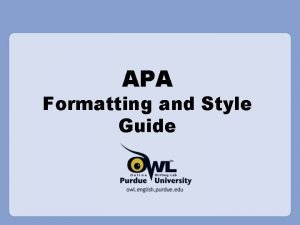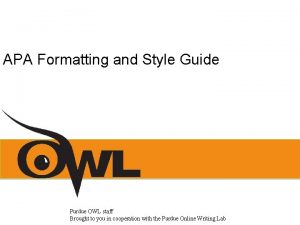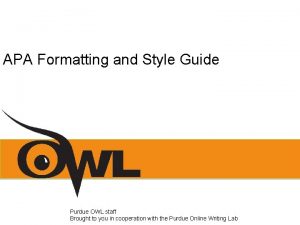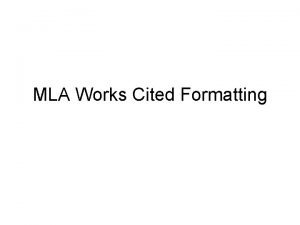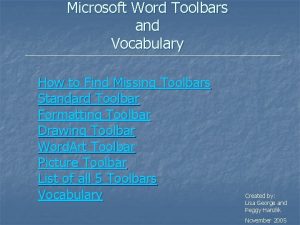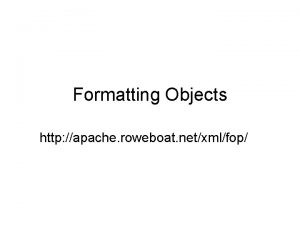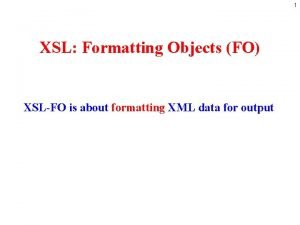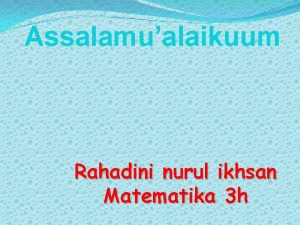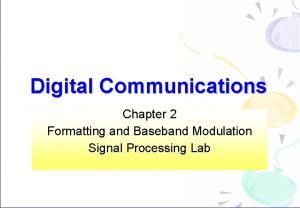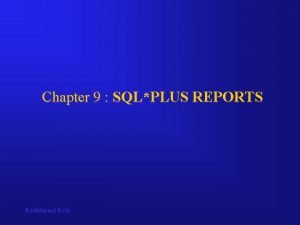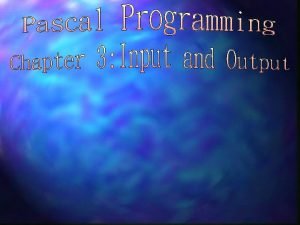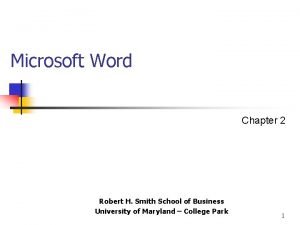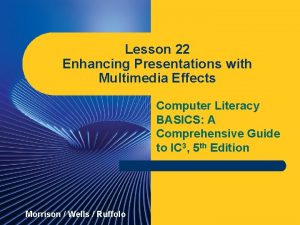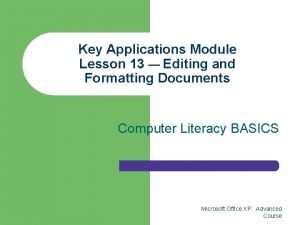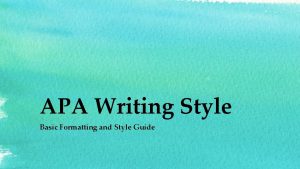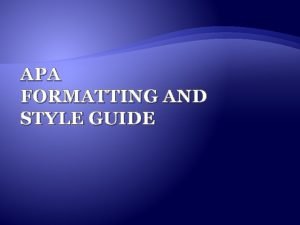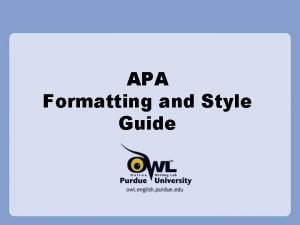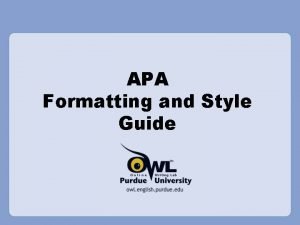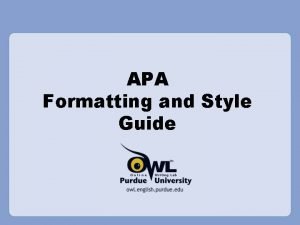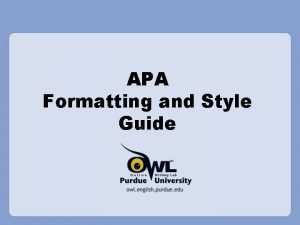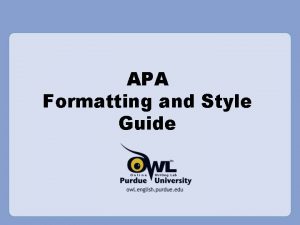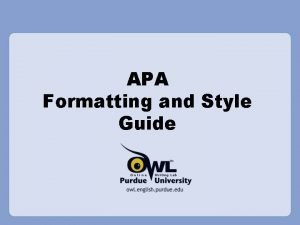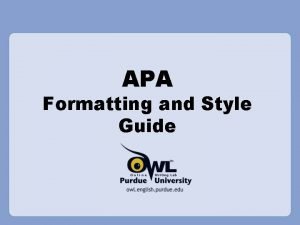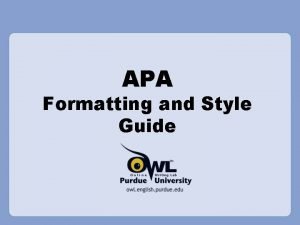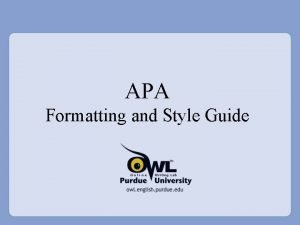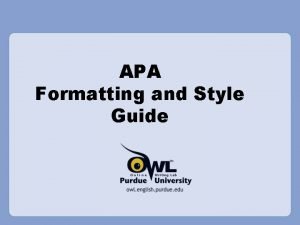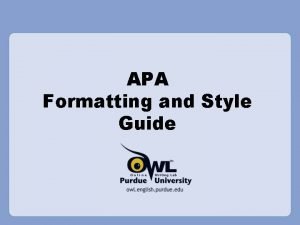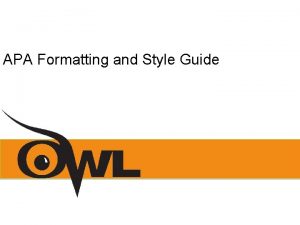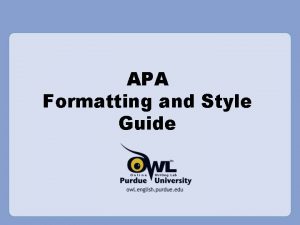APA Formatting and Style Guide What is APA


























- Slides: 26

APA Formatting and Style Guide

What is APA? The American Psychological Association (APA) citation style is the most commonly used format for manuscripts in the social sciences. APA regulates: • Stylistics • In-text citations • References

APA Style: Language in an APA paper is: • clear: be specific in descriptions and explanations • concise: condense information when you can • plain: use simple, descriptive adjectives and minimize figurative language

General Format

General Format Your essay should: • be typed and double-spaced • be printed on standard-sized paper (8. 5”x 11”) • use 1” margins on all sides • use 12 pt. Times New Roman or a similar font • include a page header (title) in the upper left-hand of every page and a page number in the upper righthand side of every page Note: If you are writing a manuscript draft, APA suggests using two spaces between sentences to aid readability (see pp. 87 -88 in the APA manual).

Title Page header: (use Insert Page Header) title flush left + page number flush right. Title: (in the upper half of the page, centered) name (no title or degree) + affiliation (university, etc. )

Main Body (Text) • Number the first text page as page number 2 • Type and center the title of the paper at the top of the page • Type the text double-spaced with all sections following each other without a break • Identify the sources you use in the paper in parenthetical in-text citations

References Basics

References Page • Center the title (References) at the top of the page. Do not bold it. • Double-space reference entries • Flush left the first line of the entry and indent subsequent lines • Order entries alphabetically by the author’s surnames • Example: http: //flash 1 r. apa. org/apastyle/ba sics/data/resources/referencesexample. pdf

References: Basics • Invert authors’ names (last name first followed by initials: “Smith, J. Q. ”) • Alphabetize reference list entries the last name of the first author of each work • Capitalize only the first letter of the first word of a title and subtitle, the first word after a colon or a dash in the title, and proper nouns. Do not capitalize the first letter of the second word in a hyphenated compound word.

References: Basics • Capitalize all major words in journal titles • Italicize titles of longer works such as books and journals • Do not italicize, underline, or put quotes around the titles of shorter works such as journal articles or essays in edited collections

Making the References List APA is a complex system of citation. When compiling the reference list, the strategy below might be useful: 1. Identify the type of source: Is it a book? A journal article? A webpage? 2. Find a sample of citing this type of source in the textbook or in the OWL APA Guide: http: //owl. english. purdue. edu/owl/resource/560/01/ 3. “Mirror” the sample 4. Make sure that the entries are listed in the alphabetical order and the subsequent lines are indented (Recall References: Basics)

In-text citations The Basics

In-text Citations: Basics In-text citations help readers locate the cited source in the References section of the paper. Whenever you use a source, provide in parenthesis: • the author’s name and the date of publication • for quotations and close paraphrases, provide the author’s name, date of publication, and a page number

In-text Citations: Formatting Quotations When quoting, introduce the quotation with a signal phrase. Make sure to include the author’s name, the year of publication, the page number, but keep the citation brief—do not repeat the information. Caruth (1996) has stated that a traumatic response frequently entails a “delayed, uncontrolled repetitive appearance of hallucinations and other intrusive phenomena” (p. 11). A traumatic response frequently entails a “delayed, uncontrolled repetitive appearance of hallucinations and other intrusive phenomena” (Caruth, 1996, p. 11).

In-text Citations: Formatting a Summary or Paraphrase Provide the author’s last name and the year of publication in parenthesis after a summary or a paraphrase. Though feminist studies focus solely on women's experiences, they err by collectively perpetuating the masculine-centered impressions (Fussell, 1975).

In-text Citations: Formatting a Summary or Paraphrase When including the quotation in a summary/paraphrase, also provide a page number in parenthesis after the quotation: According to feminist researchers Raitt and Tate (1997), “It is no longer true to claim that women's responses to the war have been ignored” (p. 2).

In-text Citations: Signal Words Introduce quotations with signal phrases, e. g. According to X. (2008), “…. ” (p. 3). X. (2008) argued that “……” (p. 3). Use such signal verbs as: acknowledged, contended, maintained, responded, reported, argued, concluded, etc.

In-text Citations: Two or More Works When the parenthetical citation includes two or more works, order them in the same way they appear in the reference list—the author’s name, the year of publication—separated by a semi-colon. (Kachru, 2005; Smith, 2008)

In-text Citations: A Work with Three to Five authors When citing a work with three to five authors, identify all authors in the signal phrase or in parenthesis. (Harklau, Siegal, & Losey, 1999) In subsequent citations, only use the first author's last name followed by "et al. " in the signal phrase or in parentheses. (Harklau et al. , 1993)

In-text Citations: A Work with Two Authors When citing a work with two authors, use “and” in between authors’ name in the signal phrase and “&” between their names in parenthesis. According to feminist researchers Raitt and Tate (1997), “It is no longer true to claim that women's responses to the war have been ignored” (p. 2). Some feminists researchers question that “women's responses to the war have been ignored” (Raitt & Tate, 1997, p. 2).

In-text Citations: A Work with Six and More Authors When citing a work with six and more authors, identify the first author’s name followed by “et al. ” Smith et al. (2006) maintained that…. (Smith et al. , 2006)

In-text Citations: A Work of Unknown Author When citing a work of unknown author, use the source’s full title in the signal phrase and cite the first word of the title followed by the year of publication in parenthesis. Put titles of articles and chapters in quotation marks; italicize titles of books and reports. According to “Indiana Joins Federal Accountability System” (2008), … Or, (“Indiana, ” 2008)

In-text Citations: Organization When citing an organization, mention the organization the first time when you cite the source in the signal phrase or the parenthetical citation. The data collected by the Food and Drug Administration (2008) confirmed that… If the organization has a well-known abbreviation, include the abbreviation in brackets the first time the source is cited and then use only the abbreviation in later citations. Food and Drug Administration (FDA) confirmed … FDA’s experts tested…

In-text Citations: Electronic sources When citing an electronic document, whenever possible, cite it in the author-date style. If electronic source lacks page numbers, locate and identify paragraph number/paragraph heading. According to Smith (1997), . . . (Animals section, para. 6).

The End
 Abstract page apa
Abstract page apa Mixed punctuation business letter
Mixed punctuation business letter Title page apa
Title page apa Purdue owl apa citation
Purdue owl apa citation Purdue owl apa
Purdue owl apa Apa style guide
Apa style guide New document word
New document word Magnetic read and write mechanisms
Magnetic read and write mechanisms Punctuation marks quotes
Punctuation marks quotes How should a work cited page look
How should a work cited page look Standard toolbar in ms word 2007
Standard toolbar in ms word 2007 Apache fop
Apache fop Match destination formatting excel
Match destination formatting excel Xslfo
Xslfo How to format internal thoughts in writing
How to format internal thoughts in writing Gambar toolbar formatting
Gambar toolbar formatting Gambar toolbar formatting
Gambar toolbar formatting Sqlplus format output
Sqlplus format output Which microsoft word tab contains the print command? *
Which microsoft word tab contains the print command? * Formatting in digital communication
Formatting in digital communication Sqlplus report formatting
Sqlplus report formatting Pascal writeln formatting
Pascal writeln formatting Text box formatting
Text box formatting Status bar in word 2016
Status bar in word 2016 Paragraph formatting
Paragraph formatting Enhancing a presentation with multimedia
Enhancing a presentation with multimedia Paragraph formatting
Paragraph formatting
